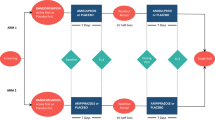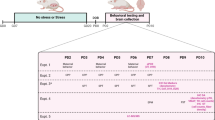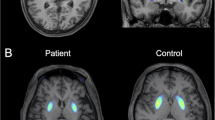Abstract
The early postpartum period is associated with increased risk for affective and psychotic disorders. Because maternal dopaminergic reward system function is altered with perinatal status, dopaminergic system dysregulation may be an important mechanism of postpartum psychiatric disorders. Subjects included were non-postpartum healthy (n=13), postpartum healthy (n=13), non-postpartum unipolar depressed (n=10), non-postpartum bipolar depressed (n=7), postpartum unipolar (n=13), and postpartum bipolar depressed (n=7) women. Subjects underwent 60 min of [11C]raclopride–positron emission tomography imaging to determine the nondisplaceable striatal D2/3 receptor binding potential (BPND). Postpartum status and unipolar depression were associated with lower striatal D2/3 receptor BPND in the whole striatum (p=0.05 and p=0.02, respectively) that reached a maximum of 7–8% in anteroventral striatum for postpartum status (p=0.02). Unipolar depression showed a nonsignificant trend toward being associated with 5% lower BPND in dorsal striatum (p=0.06). D2/3 receptor BPND did not differ significantly between unipolar depressed and healthy postpartum women or between bipolar and healthy subjects; however, D2/3 receptor BPND was higher in dorsal striatal regions in bipolar relative to unipolar depressives (p=0.02). In conclusion, lower striatal D2/3 receptor BPND in postpartum and unipolar depressed women, primarily in ventral striatum, and higher dorsal striatal D2/3 receptor BPND in bipolar relative to unipolar depressives reveal a potential role for the dopamine (DA) system in the physiology of these states. Further studies delineating the mechanisms underlying these differences in D2/3 receptor BPND, including study of DA system responsivity to rewarding stimuli, and increasing power to assess unipolar vs bipolar-related differences, are needed to better understand the affective role of the DA system in postpartum and depressed women.
Similar content being viewed by others
Log in or create a free account to read this content
Gain free access to this article, as well as selected content from this journal and more on nature.com
or
References
Bakowska JC, Morrell JI (1995). Quantitative autoradiographic analysis of D1 and D2 dopamine receptors in rat brain in early and late pregnancy. Brain Res 703: 191–200.
Berga SL, Daniels TL, Giles DE (1997). Women with functional hypothalamic amenorrhea but not other forms of anovulation display amplified cortisol concentrations. Fertil Steril 67: 1024–1030.
Byrnes EM, Byrnes JJ, Bridges RS (2001). Increased sensitivity of dopamine systems following reproductive experience in rats. Pharmacol Biochem Behav 68: 481–489.
Cannon DM, Klaver JM, Peck SA, Rallis-Voak D, Erickson K, Drevets WC (2009). Dopamine type-1 receptor binding in major depressive disorder assessed using positron emission tomography and [11C]NNC-112. Neuropsychopharmacology 34: 1277–1287.
Cassano P, Lattanzi L, Soldani F, Navari S, Battistini G, Gemignani A et al (2004). Pramipexole in treatment-resistant depression: an extended follow-up. Depress Anxiety 20: 131–138.
Champagne FA, Chretien P, Stevenson CW, Zhang TY, Gratton A, Meaney MJ (2004). Variations in nucleus accumbens dopamine associated with individual differences in maternal behavior in the rat. J Neurosci 24: 4113–4123.
Condon JT, Corkindale CJ (1998). The assessment of parent-to-infant attachment: development of a self-report questionnaire instrument. J Reproduct Infant Psychol 16: 57–76.
D’haenen HA, Bossuyt A (1994). Dopamine D2 receptors in depression measured with single photon emission computed tomography. Biol Psychiatry 35: 128–132.
Di Paolo T, Poyet P, Labrie F (1982). Effect of prolactin and estradiol on rat striatal dopamine receptors. Life Sci 31: 2921–2929.
Drevets WC, Gautier C, Price JC, Kupfer DJ, Kinahan PE, Grace AA et al (2001). Amphetamine-induced dopamine release in human ventral striatum correlates with euphoria. Biol Psychiatry 49: 81–96.
Drevets WC, Price JL, Bardgett ME, Reich T, Todd RD, Raichle ME (2002). Glucose metabolism in the amygdala in depression: relationship to diagnostic subtype and plasma cortisol levels. Pharmacol Biochem Behav 71: 431–447.
Dunlop BW, Nemeroff CB (2007). The role of dopamine in the pathophysiology of depression. Arch Gen Psych 64: 327–337.
Dziedzicka-Wasylewska M, Willner P, Papp M (1997). Changes in dopamine receptor mRNA expression following chronic mild stress and chronic antidepressant treatment. Behav Pharmacol 8: 607–618.
Ebert D, Feistel H, Loew T, Pirner A (1996). Dopamine and depression-striatal dopamine D2 receptor SPECT before and after antidepressant therapy. Psychopharmacology 126: 91–94.
England R (1994). Infant development and management of infant problems in a family setting. Aust Fam Physician 23: 1877–1882.
First MB, Spitzer RL, Gibbon M, Williams JBW (1998). Structured Clinical Interview for DSM-IV Axis I Disorders: Patient Edition. New York State Psychiatric Institute, Biometrics Research Department: New York.
Forbes EE, Dahl RE (2005). Neural systems of positive affect: relevance to understanding child and adolescent depression? Dev Psychopathol 17: 827–850.
Forbes EE, Hariri AR, Martin SL, Silk JS, Moyles DL, Fisher PM et al (2009). Altered striatal activation predicting real-world positive affect in adolescent major depressive disorder. Am J Psychiatry 166: 64–73.
Gaynes BN, Gavin N, Meltzer-Brody S, Lohr KN, Swinson T, Gartlehner G et al (2005). Perinatal depression: prevalence, screening accuracy, and screening outcomes. Evid Rep Technol Assess 119: 1–8.
Glaser J, Russell VA, de Villiers AS, Searson JA, Taljaard JJF (1990). Rat monoamine and serotonin S2 receptor changes during pregnancy. Neurochem Res 15: 949–956.
Goodman JH (2004). Paternal postpartum depression, its relationship to maternal postpartum depression, and implications for family health. J Adv Nurs 45: 26–35.
Goodman SH, Gotlib IH (1999). Risk for psychopathology in the children of depressed mothers: a developmental model for understanding mechanisms of transmission. Psychol Rev 106: 458–490.
Grace AA (1991). Phasic vs tonic dopamine release and the modulation of dopamine system responsivity: a hypothesis for the etiology of schizophrenia. Neuroscience 41: 1–24.
Gunn RN, Sargent PA, Bench CJ, Rabiner EA, Osman S, Pike VW et al (1998). Tracer kinetic modeling of the 5-HT1A receptor ligand [carbonyl-11C]WAY-100635 for PET. Neuroimage 8: 426–440.
Gurevich EV, Joyce JN (1999). Distribution of dopamine D3 receptor expressing neurons in the human forebrain: comparison with D2 receptor expressing neurons. Neuropsychopharmacology 20: 60–80.
Haber SN, Fudge JL, McFarland NR (2000). Striatonigrostriatal pathways in primates form an ascending spiral from the shell to the dorsolateral striatum. J Neurosci 20: 2369–2382.
Hall H, Sedvall G, Magnusson O, Kopp J, Halldin C, Farde L (1994). Distribution of D1 and D2-dopamine receptors and dopamine and its metabolites in the human brain. Neuropsychopharmacology 11: 245–256.
Halldin C, Farde L, Hogberg T, Hall H, Strom P, Ohlberger A et al (1991). A comparative PET study of five carbpn-11 or fluorine-18 labelled salicylamides. Preparation and in vitro dopamine D-2 receptor binding. Nucl Med Biol 18: 871–881.
Hansen S, Harthon C, Wallin E, Lofberg L, Svensson K (1991). Mesotelencephalic dopamine system and reproductive behavior in the female rat: effects of ventral tegmental 6-hydroxydopamine lesions on maternal and sexual responsiveness. Behavioral Neuroscience 105: 588–598.
Kendell R, Chalmers J, Platz C (1987a). Epidemiology of puerperal psychoses. Br J Psychiatry 150: 662–673.
Kendell RE, Chalmers JC, Platz C (1987b). Epidemiology of puerperal psychoses. Br J Psychiatry 150: 662–673.
Kendler KS, Neale MC, Kessler RC, Heath AC, Eaves LJ (1993). The lifetime history of major depression in women. Reliability of diagnosis and heritability. Arch Gen Psychiatry 50: 863–870.
Klimke A, Larisch R, Janz A, Vosberg H, Muller-Gartner HW, Gaebel W (1999). Dopamine D2 receptor binding before and after treatment of major depression measured by [123I]IBZM SPECT. Psychiatry Res 90: 91–101.
Lammers C-H, D’Souza U, Qin Z-H, Lee S-H, Yajima S, Mouradian MM (1999). Regulation of striatal dopamine receptors by estrogen. Synapse 34: 222–227.
Lammertsma AA, Bench CJ, Hume SP, Osman S, Gunn K, Brooks DJ et al (1996). Comparison of methods for analysis of clinical [11C]raclopride studies. J Cereb Blood Flow Metab 16: 42–52.
Laruelle M (2000). Imaging synaptic neurotransmission with in vivo binding copetition techniques: a critical review. J Cereb Blood Flow Metabol 20: 423–451.
Logan J, Fowler JS, Volkow ND, Ding YS, Wang G-J, Alexoff DL (2001). A strategy for removing the bias in the graphical analysis method. J Cereb Blood Flow Metab 21: 307–320.
Magiakou MA, Mastorakos G, Rabin D, Dubbert B, Gold PW, Chrousos GP (1996). Hypothalamic corticotropin-releasing hormone suppression during the postpartum period: implications for the increase in psychiatric manifestations at this time. J Clin Endocrinol Metab 81: 1912–1917.
Mawlawi O, Martinez D, Slifstein M, Broft A, Chatterjee R, Hwang DR et al (2001). Imaging human mesolimbic dopamine transmission with positron emission tomography. Part I: accuracy and precision of D receptor parameter measurements in ventral striatum. J Cereb Blood Flow Metab 21: 1034–1057.
Meyer JH, McNeely HE, Sagrati S, Boovariwala A, Martin K, Verhoeff NP et al (2006). Elevated putamen D receptor binding potential in major depression with motor retardation: an [11C]raclopride positron emission tomography study. Am J Psychiatry 163: 1594–1602.
Mintun MA, Raichle ME, Kilbourn MR, Wooten GF, Welch MJ (1984). A quantitative model for the in vivo assessment of drug binding sites with positron emission tomography. Ann Neurol 15: 217–227.
Moore H, Rose HJ, Grace AA (2001). Chronic cold stress reduces the spontaneous activity of ventral tegmental dopamine neurons. Neuropsychopharmacology 24: 410–419.
Morgan D, Grant KA, Gage HD, Mach RH, Kaplan JR, Prioleau O et al (2002). Social dominance in monkeys: dopamine D2 receptors and cocaine self-administration. Nat Neurosci 5: 169–174.
Moses-Kolko E, Meltzer CC, Helsel JC, Sheetz M, Mathis C, Ruszkiewicz J et al (2005). No interruption of lactation is needed after [11C]WAY 100635 or [11C]raclopride PET. J Nucl Med 46: 1765.
Munk-Olsen T, Laursen TM, Pedersen CB, Mors O, Mortensen PB (2006). New parents and mental disorders: a population-based register study. JAMA 296: 2582–2589.
Murray L (1992). The impact of postnatal depression on infant development. J Child Psychol Psychiatry 33: 543–561.
Narendran R, Slifstein M, Guillin O, Hwang Y, Hwang DR, Scher E et al (2006). Dopamine (D2/3) receptor agonist positron emission tomography radiotracer [11C]-(+)-PHNO is a D3 receptor preferring agonist in vivo. Synapse 60: 485–495.
Nestler EJ, Carlezon WA (2006). The mesolimbic dopamine reward circuit in depression. Biol Psychiatry 59: 1151–1159.
Nutt DJ (2006). The role of dopamine and norepinephrine in depression and antidepressant treatment. J CLin Psychiatry 67 (Suppl 6): 3–8.
Parsey RV, Oquendo MA, Zea-Ponce Y, Rodenhiser J, Kegeles LS, Pratap M et al (2001). Dopamine D receptor availability and amphetamine-induced dopamine release in unipolar depression. Biol Psychiatry 50: 313–322.
Perkins NA, Westfall TC (1978). The effect of prolactin on dopamine release from rat striatum and medial basal hypothalamus. Neuroscience 3: 59–63.
Petraglia F, De Leo V, Sardelli S, Mazzullo G, Gioffre WR, Genazzani AR et al (1987). Prolactin changes after administration of agonist and antagonist dopaminergic drugs in puerperal women. Gynecol Obstet Invest 23: 103–109.
Pizzagalli DA, Holmes AJ, Dillon DG, Goetz EL, Birk JL, Bogdan R et al (2009). Reduced caudate and nucleus accumbens response to rewards in unmedicated individuals with major depressive disorder. Am J Psychiatry 166: 702–710.
Post RM, Gerner RH, Carman JS, Gillin JC, Jimerson DC, Goodwin FK et al (1978). Effects of a dopamine antagonist piribedil in depressed patients. Arch Gen Psych 35: 609–615.
Shah PJ, Ogilvie AD, Goodwin GM, Ebmeier KP (1997). Clinical and psychometric correlates of dopamine D2 binding in depression. Psychol Med 27: 1247–1256.
Sher L, Mann JJ, Traskman-Bendz L, Winchel R, Huang YY, Fertuck E et al (2006). Lower cerebrospinal fluid homovanillic acid levels in depressed suicide attempters. J Affective Dis 90: 83–89.
Shively CA, Grant KA, Ehrenkaufer RL, Mach RH, Nader MA (1997). Social stress, depression, and brain dopamine in female cynomolgus monkeys. Ann N Y Acad Sci 807: 574–577.
Stolzenberg DS, Numan M (2011). Hypothalamic interaction with the mesolimbic DA system in the control of the maternal and sexual behaviors in rats. Neurosci Biobehav Rev 35: 826–847.
Stowe ZN, Hostetter AL, Newport DJ (2005). The onset of postpartum depression: implications for clinical screening in obstetrical and primary care. Am J Obstet Gynecol 192: 522–526.
Tonnaer JA, Leinders T, van Delft AM (1989). Ovariectomy and subchronic estradiol-17 beta administration decrease dopamine D1 and D2 receptors in rat striatum. Psychoneuroendocrinology 14: 469–476.
Valenti O, Lodge DJ, Grace AA (2011). Aversive stimuli alter ventral tegmental area dopamine neuron activity via a common action in the ventral hippocampus. J Neurosci 31: 4280–4289.
Volkow ND, Wang G-J, Fowler JS, Logan J, Gatley SJ, MacGregor RR et al (1996). Measuring age-related changes in DA D2 receptors with [11C]raclopride and with [18F]N-methylspiroperidol. Psychiatry Res 67: 11–16.
Wang GJ, Volkow ND, Logan J, Pappas NR, Wong CT, Zhu W et al (2001a). Brain dopamine and obesity. Lancet 357: 354–357.
Wang GJ, Volkow ND, Logan J, Pappas NR, Wong CT, Zhu W et al (2001b). Brain dopamine and obesity. Lancet 357: 354–357.
Willner P (1983). Dopamine and depression: a review of recent evidence. I. Empirical studies. Brain Res 287: 211–224.
Willner P, Hale AS, Argyropoulos S (2005). Dopaminergic mechanism of antidepressant action in depressed patients. J Affect Disord 86: 37–45.
Wisner KL, Chambers C, Sit DK (2006). Postpartum depression: a major public health problem. [comment]. JAMA 296: 2616–2618.
Wong DF, Brousolle EP, Wand G, Villemagne V, Dannals RF, Links JM et al (1988). In vivo measurement of dopamine receptors in human brain by positron emission tomography. Age and sex differences. Ann N Y Acad Sci 515: 203–214.
Wong DF, Wagner Jr HN, Dannals RF, Links JM, Frost JJ, Ravert HT et al (1984). Effects of age on dopamine and serotonin receptors measured by positron tomography in the living human brain. Science 226: 1393–1396.
Woods RP, Mazziotta JC, Cherry SR (1993). MRI-PET registration with automated algorithm. J Comput Assist Tomogr 17: 536–546.
Zald DH, Boileau I, El-Dearedy W, Gunn R, McGlone F, Dichter GS et al (2004). Dopamine transmission in the human striatum during monetary reward tasks. J Neurosci 24: 4105–4112.
Zarate Jr CA, Payne JL, Singh J, Quiroz JA, Luckenbaugh DA, Denicoff KD et al (2004). Pramipexole for bipolar II depression: a placebo-controlled proof of concept study. Biol Psychiatry 56: 54–60.
Acknowledgements
We thank members of the PET Facility Staff who carried out the acquisition of PET data and care of all subjects during PET procedures; Tova Saul, Andrea Confer, Michael Lightfoot, Carl Becker, Danielle Mullen, Julie Giombetti, and Alicia Corominal who assisted with study recruitment, data entry, image analysis, and endocrine analyses; NIMH, NARSAD for supporting this research; Magee-Women's Clinical Research Center and Womens Behavioral HealthCARE for providing infrastructure to run this project; and Medela for donating a breast pump for use during scanning procedures. The study was financially supported by National Alliance for Research in Schizophrenia and Depression; MH64561 to ELMK; M01-RR000056 to University of Pittsburgh; CCM's time was supported by K24 MH64625; and KLW's time was supported by MH 57102 and MH 53735. Data for non-postpartum control subjects were obtained with R01 MH042984.
Author information
Authors and Affiliations
Corresponding author
Ethics declarations
Competing interests
Eydie L Moses-Kolko: Small honorarium given as guest speaker for La Leche League Regional Conference Summer, 2009.
Julie Price: No financial interests to disclose.
Katherine L Wisner: Katherine L. Wisner received transdermal estradiol patches and matching placebo patches for an NIMH-funded randomized controlled trial, and participated in an advisory board for Eli Lilly Company.
Carolyn C Meltzer: No financial interests to disclose.
Sarah Berga: Board of Directors: Member, University of Virginia Medical Alumni Association Board of Directors, 2007 to present (Gratis). CONSULTANTSHIP: Agile Therapeutics Medical Advisory Board, March 2011; AHC Media; LLC, Consultant, Annual business meeting, April 2008, April 2009, June 2010; Noven Pharmaceutical Medical Advisory Board, Feb 2010; Promedica Communications, Bayer Pharmaceutical Medical Advisory Board Meeting, June 2009, August 2009; Watson Pharmaceutical Women's Health Strategic Advisory Board, April 2010. LEGAL CONSULTING: Kirkland and Ellis, LLC; Leydig, Voit and Mayer, LLC; Reed Smith, LLC. Editorial Boards and Positions: ACOG, Editorial Committee, Guidelines for Women's Health Care, 2009–2011(Gratis); American Journal of Obstetrics and Gynecology, 2003 to present (Gratis); Advisory Board for Subspecialty Neuroendocrinology and Reproductive Neurobiology; The Endocrine Society: Member, Endocrine Self-Assessment Program Committee (June 2007–June 2011); Clinical Practice Guideline Task Force on Hypothalamic Amenorrhea, January 2011 to present (Gratis);Editorial Board for Endocrinology, January 2010 to present (Gratis); Menopause, Editorial Board, 1999 to present (Gratis). NIH Study Section reviewer: Society for Women's Health Research, ISIS CVD Network Member, 2009 to present. UpToDate Peer Review Board for 2005 to present.
Anthony A Grace: Consultant for Johnson & Johnson; research grants from Lundbeck, GSK, EMD Serono, pharmaceutical company talks (Abbott, Roche, Lilly); advisory boards (as non-member invited speaker, including Merck).
Barbara H Hanusa: No financial interests to disclose.
Teresa Lanza di Scalea: No financial interests to disclose.
Walter H Kaye: No financial interests to disclose.
Carl Becker: No financial interests to disclose.
Wayne C Drevets: Has served as a consultant to Pfizer, Johnson and Johnson, Eisai, and Rules Based Medicine.
Additional information
Supplementary Information accompanies the paper on the Neuropsychopharmacology website
Supplementary information
PowerPoint slides
Rights and permissions
About this article
Cite this article
Moses-Kolko, E., Price, J., Wisner, K. et al. Postpartum and Depression Status are Associated With Lower [11C]raclopride BPND in Reproductive-Age Women. Neuropsychopharmacol 37, 1422–1432 (2012). https://doi.org/10.1038/npp.2011.328
Received:
Revised:
Accepted:
Published:
Issue date:
DOI: https://doi.org/10.1038/npp.2011.328
Keywords
This article is cited by
-
Alterations in adolescent brain serotonin (5HT)1A, 5HT2A, and dopamine (D)2 receptor systems in a nonhuman primate model of early life adversity
Neuropsychopharmacology (2024)
-
Altered dynamics of the prefrontal networks are associated with the risk for postpartum psychosis: a functional magnetic resonance imaging study
Translational Psychiatry (2021)
-
Sex differences and the neurobiology of affective disorders
Neuropsychopharmacology (2019)
-
The maternal reward system in postpartum depression
Archives of Women's Mental Health (2019)
-
Understanding Peripartum Depression Through Neuroimaging: a Review of Structural and Functional Connectivity and Molecular Imaging Research
Current Psychiatry Reports (2017)



